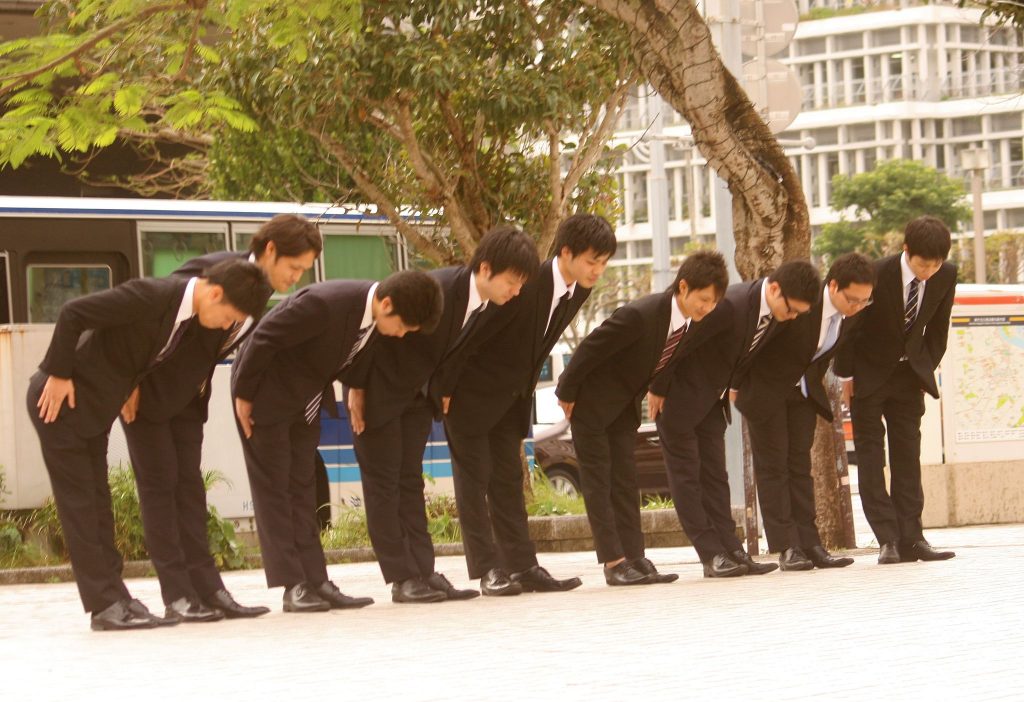Getting the tone right.

Main image source – Wikipedia
I was once told a story by a friend about his time working in Japan for a Japanese company. What he learnt from that experience (and then told me) changed the way I use Japanese during my own working life. If you struggle with “fitting in”, this may be the most important lesson.
Many foreigners complain that they can never fully “integrate” with the Japanese way of life. What that means depends on the person, but a component is certainly “how easily Japanese interact with you” on a daily basis. In other words, how easily do they forget you are foreign and treat you like everyone else.
There are a variety of reasons cited for this, such as not looking Japanese or being too independent thinking (as opposed to the more Japanese group oriented way of thinking). These reasons all have a basis in reality (your face will always give you away unless you are ethnically East-Asian), but an often overlooked factor was clearly spelled out for me by my friend as we spoke over lunch.
The story starts in my friends old workplace, where he and another western colleague (lets call him Gerry) worked together in an office. They both were hard workers doing basically the same job (translation of company technical documents to English for distribution worldwide) however socially the Japanese staff warmed to my friend more than Gerry. Their Japanese was equally high-level, their translations were of comparable quality and speed, but Gerry found himself more isolated during social engagements, and less “listened to” during meetings and other discussions.

One day, my friend was talking to one of his Japanese colleagues and the subject of Gerry came up. “You know”, the Japanese colleague said, “I find talking to Gerry quite difficult at times”. “Why was that?”, my friend asked back. Gerry’s Japanese was in many ways superior to his own, particularly vocabulary and accent. Why would speaking to Gerry be more difficult? The Japanese colleague continued to explain. “Gerry’s Japanese is more fluent for sure, but yours is more natural. You speak like a Japanese”.
How could this be? Surely the better accent, vocabulary and fluency is an advantage when trying to communicate? What was poor Gerry missing that caused such frustration in his Japanese colleagues?
The Japanese colleague continued, “Gerry doesn’t change the way he speaks depending on who he speak to. All his language is ‘rough’, regardless of who he speaks to”. My friend began to understand, nodding in agreement, “You change your speech depending on the person you are speaking to. That is very natural to us Japanese”.
For Japanese speakers and learners, the concept of ‘polite speech” is a common sight in the pages of more advanced textbooks. You can Google “politeness levels japanese” and find technical explanations easily – this Wikipedia article is a good start. From that you can learn “what” to say, but in practice there are a few points that you need to know to avoid wasting your time and to get the most for your efforts.
Know your place and use appropriate language
I won’t go into the language details here. You can find out the basics on any language learning website. For non-learners of Japanese all you need to know is that there are various “levels” of politeness in Japanese, as with any language. While in English, we tend to stick to a level based on the general situation, Japanese will flick between each level midway, depending on who they are addressing.
Imagine talking in a group in English, and responding to a younger friend’s interesting comment with “really?”, while responding to a similar comment from an older person in the same conversation with “oh, is that the case?”. Try it out in your head. Doesn’t feel right, does it? You are likely to get labeled a bootlicker, with everyone including the older person suspecting you want something.
This is perfectly acceptable in Japanese, and as my friend discovered and told me, expected in order to truly fit in. I noticed this at a work gathering one evening, where a former longtime colleague of mine got into a conversation with me and my boss – his elder by a good 10 years. When addressing me, his language was casual, but when addressing my boss (his elder and also not part of his department) his language was much politer – “do you want another drink?” to me, changed to “would you like another drink?” in the very next sentence to my boss. What does that guy want? A promotion?
English has its polite language, that can be brought out for appropriate situations, but not to the fine-grained levels of Japanese, and not so easily mixed and matched depending on who you are facing at the time.
However, don’t over do it
When I lived in the UK, a Latvian colleague of mine said the price of some chocolate in the local cafe was “one quid” (“quid” means “pound” in the UK – the currency, not the weight). I told him “it’s a quid, not one quid. No one says one quid”. You say two quid, but one is always “a”. It is also never ten quids, there is no “s” on the end, ever.
Basic British slang lesson over, the point is that if you use slang incorrectly, there is no point using is, at least as a foreigner. Your attempt to “fit in” that goes wrong, just makes you stand out more. That overly pronounced, carefully enunciated “you’re having a giraffe” just doesn’t work without the fluency and half-pronounced cocky accent it usually comes with (“yer ‘aving’ a jerarf?”). Who says that nowadays, anyway?
If you mess up “keigo“, the ultra polite speech form in Japanese used to show respect to customers, bosses and elders, you will stand out even more as a non-native speaker. In most situations, you would never be expected to use it – and if you were, you would get lessons and be expected to practice (I have a Chinese friend who visits Japanese customers alone, at their premises. He needs perfect keigo and his bosses know he is capable, otherwise they would never let him go alone).

Now for the Japanese speakers, here are the technical details.
- Get your です/ます correct. Remove it when speaking to in-group or younger colleagues, and include it when speaking to bosses, older colleagues or anyone out-group.
- When talking to yourself, about yourself, use casual language “どこだっけ?”. If you are talking to someone else, use “どこでしたっけ?”. Don’t mutter to yourself in polite speech.
- Use “〜させて頂きます”. It is an easy pattern to learn and pronounce and good for starting presentations “これから説明させて頂きます”.
- When asking someone to do something, e.g. “click this button and…”, use ボタンをクリックして頂いて…
- Learn 弊社、御社 and use it correctly.
- Don’t forget peoples names, ever. If you do, ask someone else to remind you of that person’s name, not the person themselves. You’ve had that, haven’t you, and you thought it was because you were foreign. No, all Japanese do it to everyone. It’s rude to directly ask someone to repeat their name because you forgot.
- Don’t both with learning all the humble language for 見る, etc. Just remember ご覧になりましたか and ご存知でしょうか. That is all you need.
- When recommending to do something, use 〜して頂ければと思います。Very nice bit of polite speech and easy to use.
- Don’t overdo the polite verb endings. Just one at the end is fine. Too many ”〜させて頂いて” just sounds awkward.
- Do learn how to use “〜しております”. But that’s all you need.
- Do use おっしゃる and いっらっしゃる. Almost always in the phrases ”Xさんがおっしゃった通り” and ”〜いっらっしゃらないでしょうか”
By all means, learn more. However, unless you are using it a lot and get a great deal of practice, you will end up making a lot of mistakes, flubbing the pronunciation (カミカミ) and so ruining your impression. It is better to get a a basic set compete and fixed into your regular speech, so that it becomes natural.

